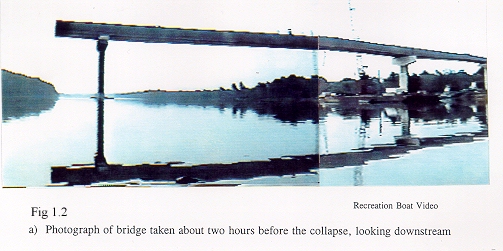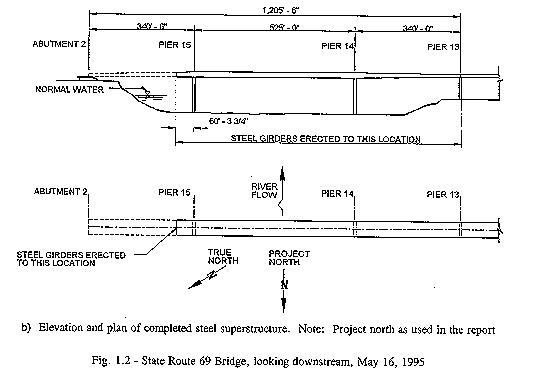Wiss, Janney, Elstner Associates, Inc.
Collapse of the State Route 69 Bridge
over the Tennessee River at Clifton, Tennessee
for
Office of the Attorney General, State of Tennessee
WJE No. 951078
|
Wiss Janney, Elstner Associates, Inc. Northbrook, Illinois |
Michael Koob Jonathan C. McGormley Howard J. Hill Neal S. Anderson |
|
December 1995 |
|
| 1.1 Background |
| 1.2 Overview of Investigation |
| 1.3 Organization of Report |
A major failure of the three-span State Route 69 Bridge occurred on Tuesday morning, May 16, 1995, when the two erected spans of the steel superstructure suddenly collapsed and fell into the Tennessee River. Three ironworkers were working on the steel superstructure at the time and fell into the river. Two of the men were recovered uninjured; the third drowned and was recovered five days later.
| The State Route 69 Bridge at Clifton, Tennessee, was designed by the Tennessee Department of Transportation and was scheduled to be completed in June 1995. It is located between Hardin and Decatur counties near Clifton, Tennessee, as shown by the map in Figure 1-1 Location Map. The bridge was designed to carry two lanes of traffic, one in each direction, over the Tennessee River. The three-span steel river crossing had a total length of 1,205 feet-6 inches, a roadway width of 48 feet, and an average height of about 80 feet above the Tennessee River. |
|
A photograph reproduced from a videotape of the State Route 69 Bridge taken the morning of the collapse is shown in Figure 1-2a. An elevation and plan of the completed steel structure is illustrated in Figure 1-2b.


At approximately 9:45 a.m. on May 16, 1995, the two-plus spans of the steel superstructure collapsed while erection was in progress. Figure 1-3 shows the bridge site within hours of the collapse. This photograph shows a cross frame from the steel superstructure that was being worked on at the time of the collapse still being held by the crane.

Wiss, Janney, Elstner Associates, Inc., (WJE) began an investigation on May 17, 1995, to make a determination of the cause of the collapse. The first work was to observe the removal and demolition of the steel members. This also provided an opportunity to identify each member and to examine and record conditions at the site. Access to the structural members was an immediate problem. Many members of interest came to rest below the surface of the Tennessee River.
The removal operation was carried out with recognition of the urgency to clear the main channel for river traffic. Within a few days of the collapse, divers were used to document the condition of the structural members before demolition operations. The general contractor decided to use linear explosives to cut the massive girders into manageable lengths for removal from the river. During the course of this work, Pier 14 fell into the river. As the pieces of the girder were removed, they were taken to open areas along the Hardin County riverbank and laid out for examination. The last pieces of structural steel were removed by the end of July 1995. Investigative work at the site was essentially completed in early August 1995. Removal of steel samples for metallographic examination began the beginning of November 1995. This metallographic examination work was completed in early 1996.
While the removal work progressed, documents and information relevant to the erection of the bridge and its collapse were assembled. These documents provided background information for the investigation.
This [student-accessable version of the accident] report is organized into four chapters. Chapters 2 and 3 contain background information. Chapter 2 consists of a description of and an erection procedure for the State Route 69 Bridge. Chapter 3 is a summary of relevant information pertaining to the bridge collapse . Chapter 4 describes the field work that was carried out at the bridge site during this investigation.
NOTES:
For this case study, only Chapters 1-4 will be immediately available to the students.
Some of the material in Chapter 3 will be available only after the completion of Assignment 1.
Chapters 5-10 will be available for review at the end of the case study
Back to page top
To WJE Report Chapter 2
WJE Report Table of Contents